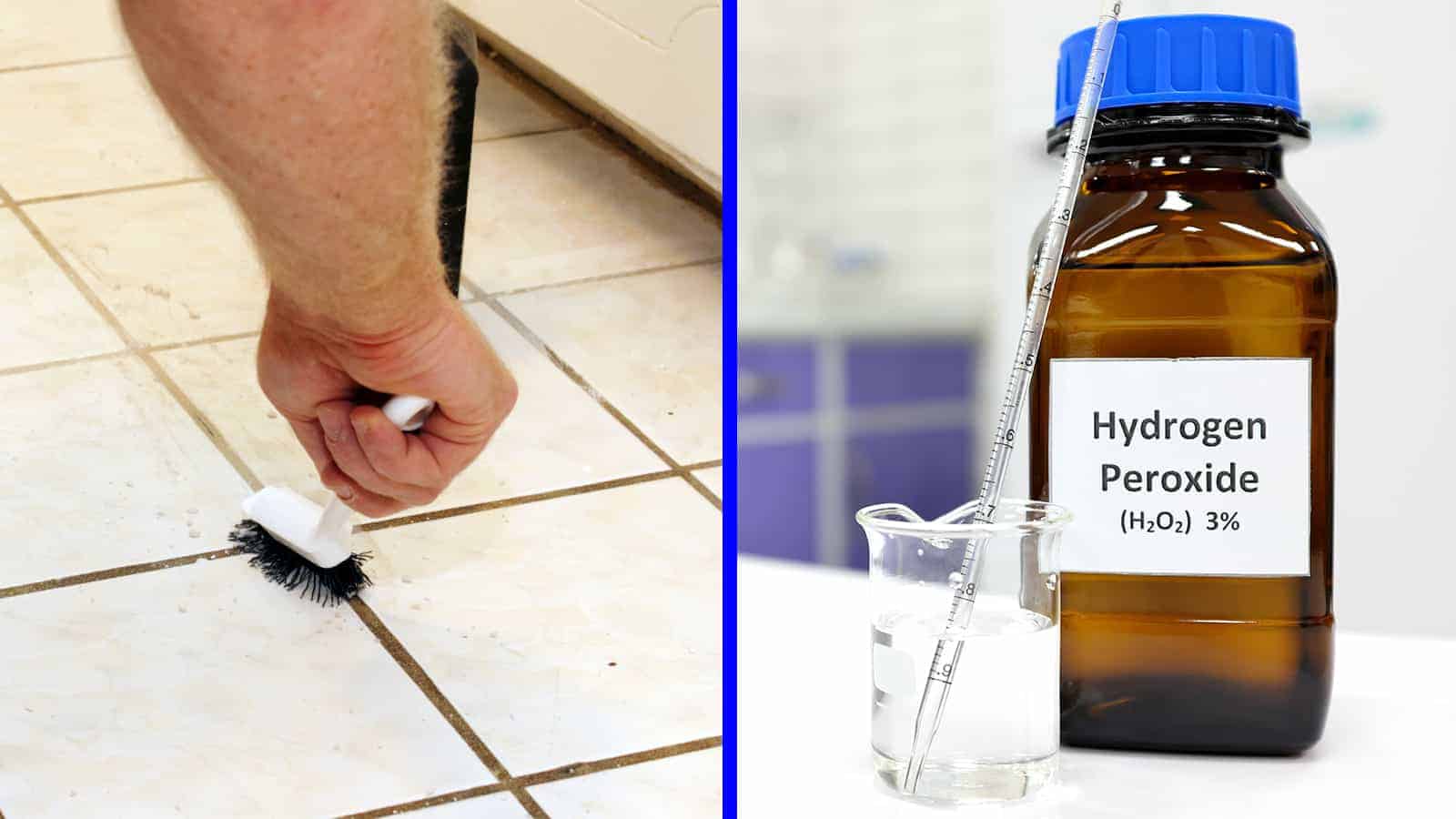Hydrogen peroxide is an everyday household staple, but the benefits go much further than expected. If you use hydrogen peroxide for cleaning, you will experience the effects of one of the best all-natural cleaners. It is inexpensive, safe, and kills harmful viruses, bacteria, and fungi.
Hydrogen peroxide comprises two oxygen atoms and two hydrogen atoms, making the chemical compound H2O2. You can find peroxide in varying concentrations, most commonly between three and 10%. The best peroxide concentration for cleaning and disinfecting is the three percent solution.
Hydrogen peroxide starts to break down when exposed to heat, light, or air and becomes plain water. It isn’t harmful when this happens, but it won’t work well for cleaning once this occurs. This breakdown is the reason that peroxide comes in a brown bottle.
How to Use Hydrogen Peroxide for Cleaning
Not only can you be more efficient by using hydrogen peroxide for cleaning, but you will also save money. If you aren’t buying expensive chemical-filled cleaners, you can put that money aside for something better. The best part is that hydrogen peroxide poses no health or environmental hazards.

1. De-gunk Your Tiles, Granite, Marble, and Grout
Keeping tiles, granite, marble, and grout clean can be difficult if you don’t have the right solution. Spraying hydrogen peroxide on the surfaces can help clean them and even whiten the grout.
To clean the grout, leave peroxide for thirty minutes before scrubbing. You can scour with a grout brush or an old toothbrush. Removing your grout might take a few applications if it has many buildups.
Granite, tiles, and marble show water stains, and food stains can be harder to clean off. Using a mixture of hydrogen peroxide and baking soda can help.
Use half a cup of baking soda with a few drops of peroxide to form a paste, then spread it over your countertops. Let it sit for 10 minutes before cleaning it with a wet cloth.
2. Use Hydrogen Peroxide for Cleaning Your Beds and Mattresses
Most people don’t realize they should clean their mattresses every six months. To clean them, remove the linens and padding, and vacuum the mattress thoroughly.
If you see any stains on the mattress, you can use a mixture of equal parts water and hydrogen peroxide. Use a soft, clean toothbrush or other cleaning brush, and then work the ingredients into the stain. Let it sit for five minutes, and then repeat the process.
Continue the process until the stain has faded, and then use a hairdryer to dry any excess moisture. Don’t put the padding or the linens back on until the mattress fully dries.
3. Lighten Up Your Bathrooms and Toilets
Bathrooms and toilets can get nasty, but hydrogen peroxide can make cleaning easier. If you have mold or mildew in your bathroom, spray it with peroxide and let it sit for a few minutes. Then, wipe it away with a wet cloth. For a thorough clean throughout your home, consider hiring carpet cleaners newport to tackle any carpet stains and keep your floors looking fresh.
Research shows that hydrogen peroxide removes bacteria, yeast, fungi, viruses, and spores, effectively cleaning your toilet. Pour half a cup of peroxide into your toilet and let it sit for fifteen minutes before scrubbing it clean. You’ll notice that the grime comes off quicker and is cleaner than ever.
4. Refinish Metal Objects
You can use hydrogen peroxide to clean and refinish any metal containing iron or an iron alloy. Before spraying the peroxide, you must remove, paint, and sand the surface. Once you have a fresh start, spray vinegar onto the surface and let it dry for five minutes.
While you wait for the vinegar to dry, mix two cups of peroxide, four tablespoons of vinegar, and one and a half teaspoons of salt. Soak the metal surface with this mixture, and you will notice that rust begins forming immediately. This method of refinishing will result in an antique-looking piece.
5. Try Hydrogen Peroxide for Cleaning Rust Stains
While hydrogen peroxide can cause rusting when mixed with the right ingredients, it can also remove rust if used differently. Mix equal parts of cream of tartar and baking soda, then add a few drops of hydrogen peroxide to form a paste.
Apply the paste to rusted objects and leave it for one hour before cleaning them with water. This method removes rust from moderately rusted items. Plus, it can remove rust stains in your sink or bathtub caused by the rust in your tap water.
6. Sanitize Your Kitchen Utensils
Using hydrogen peroxide to clean your kitchen utensils can keep things bacteria-free. Your cutting board is an excellent place to start because it gets cuts on the surface that trap unhealthy bacteria. To clean it, spray it with white vinegar first, then pour hydrogen peroxide over it after five minutes.
If you have ceramic-coated cookware, you can clean that using hydrogen peroxide, too. Spread it on the dish’s interior, and it will lighten stains while cleaning the surface. You can also use it on any utensils that are hard to clean entirely.
7. Freshen Up Your Furniture
Harsh chemicals can ruin your furniture, so using hydrogen peroxide for cleaning is a better option. Mix half a cup of dawn dish soap with one cup of hydrogen peroxide in a spray bottle. Then, spray it on your upholstery and let it sit for a few minutes before scrubbing it with a rag.
Using a large sprayer, you can also clean your outdoor furniture with hydrogen peroxide. Here is how to clean furnishings with hydrogen peroxide. Mix one gallon of warm water with one-quarter cup of peroxide, a few drops of dish soap, and one scoop of borax. Then, spray your outdoor furniture and let the mixture sit for 15 minutes before scrubbing and rinsing.

8. Use Hydrogen Peroxide for Cleaning and Sanitizing Your Appliances
Studies show that residential dishwashers often have fungi and yeast inside them. This fact is the case for other appliances too. You can use hydrogen peroxide for cleaning small appliances, though.
Mix one cup of hydrogen peroxide with two cups of water in a spray bottle. Add about fifteen drops of lemon essential oil or two teaspoons of lemon juice and then shake the bottle. You can use this all-natural cleaner on many appliances and other surfaces, including your:
- kitchen sink and garbage disposal area
- microwave
- refrigerator (inside and out)
- coffee maker
- blender
- slow cooker
- dishwasher (inside and out)
9. Shines Your Mirrors
You can use hydrogen peroxide to clean shiny mirrors with no streaks. Fill a spray bottle with equal parts water and peroxide instead of a regular window or mirror cleaner. Wipe the mirror with a lint-free cloth or newspaper for the best results.
10. Remove Stains from Your Clothes
When you have stains on your clothing, you can use hydrogen peroxide as a pretreatment a couple of hours before washing. Add one cup of hydrogen peroxide to your washing machine before wearing white clothes. Peroxide brightens the whites and removes stains naturally.
If you get underarm stains on your clothes, you can use a hydrogen peroxide mixture to remove them. Mix equal parts peroxide, baking soda, and water, and then use a soft-bristled brush to scrub the area. Then, allow the mixture to sit for at least half an hour before giving it a final scrub and throwing it in the washing machine.
You can also remove food and grass stains by combining hydrogen peroxide and one part dish soap. Use a soft-bristled brush to work the mixture into the spot and let it sit for a while. Then, rinse with cold water and apply again until you can’t see the stain anymore.
11. Eliminate Bad Odors
Hydrogen peroxide can help you eliminate foul odors, including skunk smells, urine, and other offensive odors. Peroxide destroys the odor by breaking down the source of the smell and using enzymes to remove it. It accelerates the elimination process for both foul odors and stains.
Mix one part of hydrogen peroxide with six water parts, then spray it on the area thoroughly. Blot at the area and then let it dry for a while. Repeat the process as necessary until the odor dissipates.
12. Remove Watermarks in Your Windows
If there are hard water stains on your windows, you can use hydrogen peroxide to clean them off. Mix equal parts of water and hydrogen peroxide and saturate the mark. Let the solution sit for a few minutes, then respray the glass when it dries.
Then, scrub the glass with a rough towel or rag with the mixture. Repeat this process until there are no watermarks left. You can also make a paste instead of a liquid and use it to scour the watermarks of your windows.
13. Sanitize Your Children’s Toys
You can use hydrogen peroxide to sanitize toys and stop the spread of germs in your home. Put peroxide on a rag and wipe down all of the toys and play surfaces once a week. It will kill germs and bacteria without exposing the child to harmful chemicals.
You can also fill a spray bottle with hydrogen peroxide over the toys. Let the liquid dry naturally; if it bubbles up, do it again.

Final Thoughts on Ways to Use Hydrogen Peroxide for Cleaning
Hydrogen peroxide is a safe and all-natural alternative to chemical-filled cleaners. You can also use it when you run out of your usual cleaner.
It is important to note that mixing hydrogen peroxide with bleach can cause an explosion, so avoid the combination. While it is an all-natural cleanser, hydrogen peroxide should never be consumed.
Use natural ingredients that you already have in your home to enjoy a cleaner, fresher home. Hydrogen peroxide for cleaning is an excellent alternative, and you’ll be glad you tried it out.




















